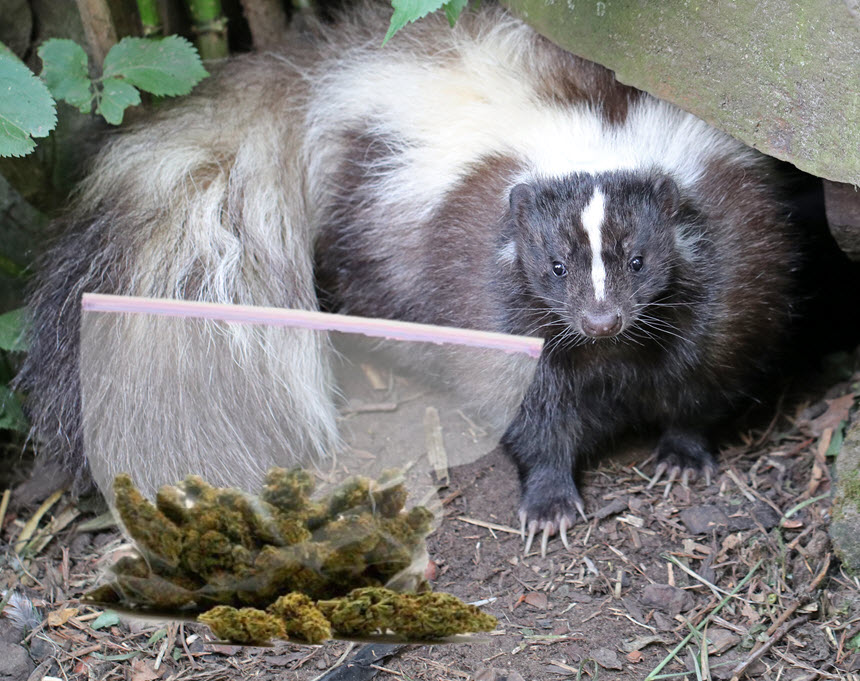
The surprising reason cannabis smells like skunk
The pungent smell of skunky weed is really clear: outdoors you can smell it from afar, and inside it can linger a lot longer than we’d like.
The unique smell of cannabis is one of the many things that are so special. With over 200 terpenes or aromatic compounds found in all plants (not just cannabis) in marijuana, it was only in recent years that scientists have discovered that these compounds play a role not only in the smell of cannabis, but also in its medicinal properties .
However, the Skunk strain left many researchers in the dark until recently.
A new study, conducted by researchers at Abstrax Tech in California and published in the ACS Omega Journal on November 12, 2021, found that the notoriously pungent smell of Skunk cannabis shares similarities in molecular structure with that of garlic – and that real skunk! Garlic is an herb that is known for its tremendous benefits, particularly against inflammation, cancer, bacteria, and viruses. They also discovered new compounds called “prenylated volatile sulfur compounds (VSCs)” that are also found in the aerosol defense sprays used by skunks.
“These compounds in garlic are some of the most important ones in terms of the health benefits of this plant in our diet,” said Iain Oswald, lead author of the study and chief scientist at the California cannabis research company Abstrax. “They contribute to the beneficial cardiovascular properties of garlic; Also, some have been shown to have certain anti-carcinogenic properties in vitro, ”he told McClatchy News. They found that the VSCs in the cannabis plant tend to be significantly more concentrated when they reach the flowering stage and also peak while they are curing. Thereafter, VSC levels decrease after the plant has been stored for 10 days, as observed in a greenhouse experiment.
“We focused specifically on identifying VSCs for two reasons: First, the aroma of cannabis is often described as ‘skunk-like’, and skunks are known for having several potent VSCs in their defensive aerosol spray. We suspected that there might be similar connections in cannabis. Second, VSCs are also important in the chemistry of other plants known for their often pungent aromas and flavors, including hops (Humulus lupulus), garlic (Allium sativum), and durian (Durio zibethinus), ”they wrote.
The unique taste and aroma of garlic are attributed to different types of VSCs, particularly triallyl disulfide and diallyl disulfide, which are quite similar to the VSCs identified in cannabis.
The researchers also performed a chemical analysis of 3 cannabis concentrate extracts and found that it contained high levels of certain compounds, proving that cannabis extracts can have the skunky aroma too. And because of the well-known health benefits of garlic, the authors believe that these VSCs in cannabis may also have some particular health benefits, although this will require more study.
“In addition, the identification of the reported VSCs definitely confirms the chemical origin of the cannabis odor and provides a new family of secondary metabolites that can be studied for their biosynthetic pathways and medical benefits,” they conclude.
Growing interest in the world of cannabis terpenes
Today we know that terpenes do much more than just add to the unique scents of cannabis.
Around 20,000 terpenes have already been identified in the plant world, which can also have a wide range of effects in the human body. You can deviate from stress relief, inflammation control, pain relief, focus, and even hallucinations. A few decades ago, the focus of cannabis research was primarily on cannabinoids, the dominant active ingredients in plants, especially THC and CBD. However, when patients were given isolated versions of these compounds, the researchers found that they did not have the same health benefits as giving patients whole herbal medicines.
Many studies on THC and CBD showed that these cannabinoids were not as effective on their own as when given with other compounds. This led the scientists to conclude that there were many other compounds in the plant that potentiated its therapeutic effects, including terpenes now known as the entourage effect. It is also interesting that aromatherapy practitioners were the ones who previously dedicated themselves to research into terpenes, although there are few and far between quality studies on cannabis terpenes. It’s good to know they’re growing as commercial and private interest in the potential of cannabis terpenes is exploding and it’s no secret.
Another interesting discovery about terpenes is that they can help cannabinoids be absorbed into the bloodstream much faster. Linalool, for example, regulates the response of neurotransmitters to THC and CBD, which leads to an anxiolytic and relaxing effect. In addition, CBD works in conjunction with certain terpenes to reduce long-term memory loss, which is a common side effect of THC, while reducing the cannabinoid’s psychoactive effects. These are just a few of the many wonderful ways terpenes work with cannabinoids to produce desirable results through the entourage effect.
What we know about terpenes today is only the tip of the iceberg. In a year from now, we are likely to see more exciting breakthroughs about these amazing aromatic compounds in the cannabis plant and how they can help us.
MORE ABOUT SKUNK WEED, READ THIS …

WHAT IS KUSH, HAZE AND SKUNK WEED? READ THIS FIRST!

Post a comment: